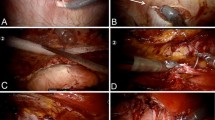Abstract
Background
Ventral hernia repair is typically performed via a transabdominal approach and the peritoneal cavity is opened and explored. Totally extraperitoneal ventral hernia repair (TEVHR) facilitates dissection of the hernia sac without entering the peritoneal cavity. This study evaluates our experience of TEVHR, addressing technique, decision-making, and outcomes.
Methods
This is an IRB-approved retrospective review of open TEVHR performed between January 2012 and December 2016. Medical records were reviewed for patient demographics, operative details, postoperative outcomes, hospital readmissions, and reoperations.
Results
One hundred sixty-six patients underwent TEVHR (84 males, 82 females) with a mean BMI range of 30–39. Eighty-six percent of patients underwent repair for primary or first-time recurrent hernia, and 89% CDC wound class I. Median hernia defect size was 135 cm2. Hernia repair techniques included Rives-Stoppa (34%) or transversus abdominis release (57%). Median operative time was 175 min, median blood loss 100 mL, and median length of stay 4 days. There were no unplanned bowel resections or enterotomies. Four cases required intraperitoneal entry to explant prior mesh. Wound complication rate was 27%: 9% seroma drainage, 18% superficial surgical site infection (SSI), and 2% deep space SSI. Five patients (3%) required reoperation for wound or mesh complications. Over the study, four patients were hospitalized for postoperative small bowel obstruction and managed non-operatively. Of the 166 patients, 96%, 54%, and 44% were seen at 3-month, 6-month, and 12-month follow-ups, respectively. Recurrences were observed in 2% of patients at 12-month follow-up. One patient developed an enterocutaneous fistula 28 months postoperatively.
Conclusions
TEVHR is a safe alternative to traditional transabdominal approaches to ventral hernia repair. The extraperitoneal dissection facilitates hernia repair, avoiding peritoneal entry and adhesiolysis, resulting in decreased operative times. In our study, there was low risk for postoperative bowel obstruction and enterotomy. Future prospective studies with long-term follow-up are required to draw definitive conclusions.
Similar content being viewed by others
References
Jones C, Winder J, Potochny J, Pauli E (2016) Posterior component separation with transversus abdominis release: technique, utility, and outcomes in complex abdominal wall reconstruction. Plast Reconstr Surg 137:636–646. https://doi.org/10.1097/01.prs.0000475778.45783.e2
Gray SH, Vick CC, Graham LA, Finan KR, Neumayer LA, Hawn MT (2008) Risk of complications from enterotomy or unplanned bowel resection during elective hernia repair. Arch Surg 143:582–586. https://doi.org/10.1007/s11605-008-0496-9
Johnson KC, Miller MT, Plymale MA, Levy S, Davenport DL, Roth JS (2016) Abdominal wall reconstruction: a comparison of totally extraperitoneal and transabdominal preperitoneal approaches. J Am Coll Surg 222:159–165. https://doi.org/10.1016/j.jamcollsurg.2015.11.012
Krishna A, Misra MC, Bansal VK, Kumar S, Rajeshwari S, Chabra A (2012) Laparoscopic inguinal hernia repair: transabdominal preperitoneal (TAPP) versus totally extraperitoneal (TEP approach: a prospective randomized controlled trial. Surg Endosc 26:639–649. https://doi.org/10.1007/s00464-011-1931-7
Baig SJ, Priya P (2018) Extended totally extraperitoneal repair (eTEP) for ventral hernias: short-term results from a single centre. J Minim Access Surg. https://doi.org/10.4103/jmas.JMAS_29_18
Belyansky I, Daes J, Radu VG, Balasubramanian R, Reza Zahiri H, Weltz AS, Sibia US, Park A, Novitsky Y (2018) A novel approach using the enhanced-view totally extraperitoneal (eTEP) technique for laparoscopic retromuscular hernia repair. Surg Endosc 32:1525–1532. https://doi.org/10.1007/s00464-017-5840-2
Heniford BT, Ross SW, Wormer BA, Walters AL, Lincourt AE, Colavita PD, Kercher KW, Augenstein VA (2018) Preperitoneal ventral hernia repair: a decade long prospective observational study with analysis of 1023 patient outcomes. Ann Surg. https://doi.org/10.1097/SLA.0000000000002966
Krpata DM, Prabhu AS, Tastaldi L, Huang LC, Rosen MJ, Poulose BK (2018) Impact of inadvertent enterotomy on short-term outcomes after ventral hernia repair: an AHSQC analysis. Surgery 164:327–332. https://doi.org/10.1016/j.surg.2018.04.003
Cheng H, Chen BP, Soleas IM, Ferko NC, Cameron CG, Hinoul P (2017) Prolonged operative duration increases risk of surgical site infections: a systematic review. Surg Infect (Larchmt) 18:722–735. https://doi.org/10.1089/sur.2017.089
Leonard J, Hieken TJ, Hussein M, Harmsen WS, Sawyer M, Osborn J, Bingener J (2016) Delineation of factors associated with prolonged length of stay after laparoscopic ventral hernia repair leads to a clinical pathway and improves quality of care. Surg Endosc 30:1614–1618. https://doi.org/10.1007/s00464-015-4391-7
Poruk KE, Farrow N, Azar F, Burce KK, Hicks CW, Azoury SC, Cornell P, Cooney CM, Eckhauser FE (2016) Effect of hernia size on operative repair and post-operative outcomes after open ventral hernia repair. Hernia 20:805–810. https://doi.org/10.1007/s10029-016-1542-2
Majumder A, Fayezizadeh M, Neupane R, Elliott HL, Novitsky YW (2016) Benefits of multimodal enhanced recovery pathway in patients undergoing open ventral hernia repair. J Am Coll Surg 222:1106–1115. https://doi.org/10.1016/j.jamcollsurg.2016.02.015
Ross SW, Oommen B, Huntington C, Walters AL, Lincourt AE, Kercher KW, Augenstein AA (2015) National outcomes for open ventral hernia repair techniques in complex abdominal wall reconstruction. Am Surg 81:778–785
Prassas D, Schumacher FJ (2018) Electric cauterization of the hernia sac in laparoscopic ventral hernia repair reduces incidence of postoperative seroma: a propensity score-matched analysis. Hernia 22:747–750. https://doi.org/10.1007/s10029-018-1790-4 (Correction: Hernia 22:751 doi: 10.1007/s10029-018-1805-1)
ten Broek RP, Schreinemacher MH, Jilesen AP, Bouvy N, Bleichrodt R, van Goor H (2012) Enterotomy risk in abdominal wall repair: a prospective study. Ann Surg 256:280–287. https://doi.org/10.1097/SLA.0b013e31826029a8
Author information
Authors and Affiliations
Corresponding author
Ethics declarations
Disclosure
Dr. Roth discloses he has grant funding from Bard and Miromatrix; he is a consultant for Bard, Johnson & Johnson, and Allergan; and he owns stock in Miromatrix.Mr. Nisiewicz, Mr. Wade and Drs. Kumar, Warriner, Chang, Plymale, Davenport, and Edmunds have no conflicts of interest or financial ties to disclose.
Additional information
Publisher's Note
Springer Nature remains neutral with regard to jurisdictional claims in published maps and institutional affiliations.
Rights and permissions
About this article
Cite this article
Kumar, S., Edmunds, R.W., Nisiewicz, M.J. et al. Totally extraperitoneal approach for open complex abdominal wall reconstruction. Surg Endosc 35, 159–164 (2021). https://doi.org/10.1007/s00464-020-07374-1
Received:
Accepted:
Published:
Issue Date:
DOI: https://doi.org/10.1007/s00464-020-07374-1




